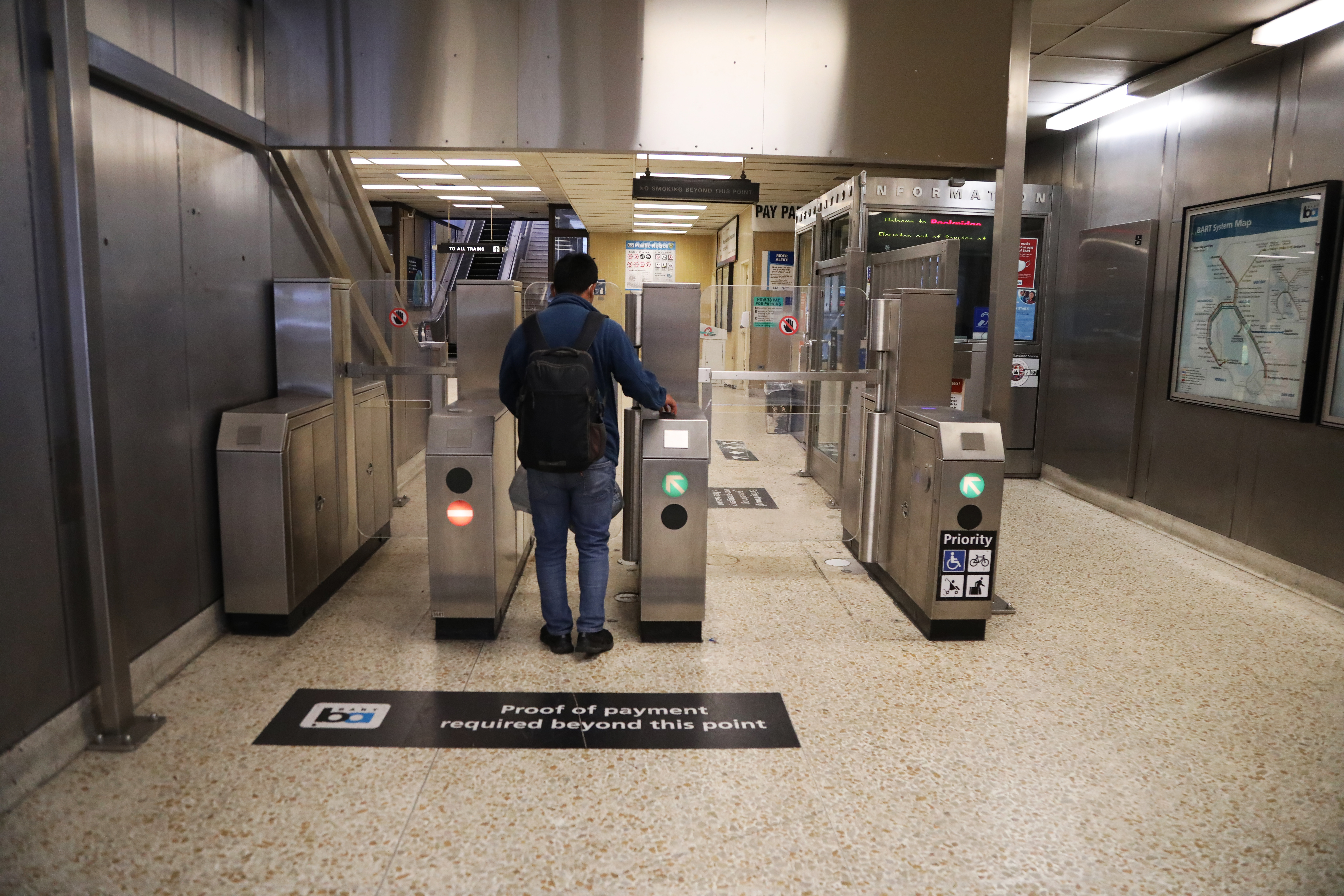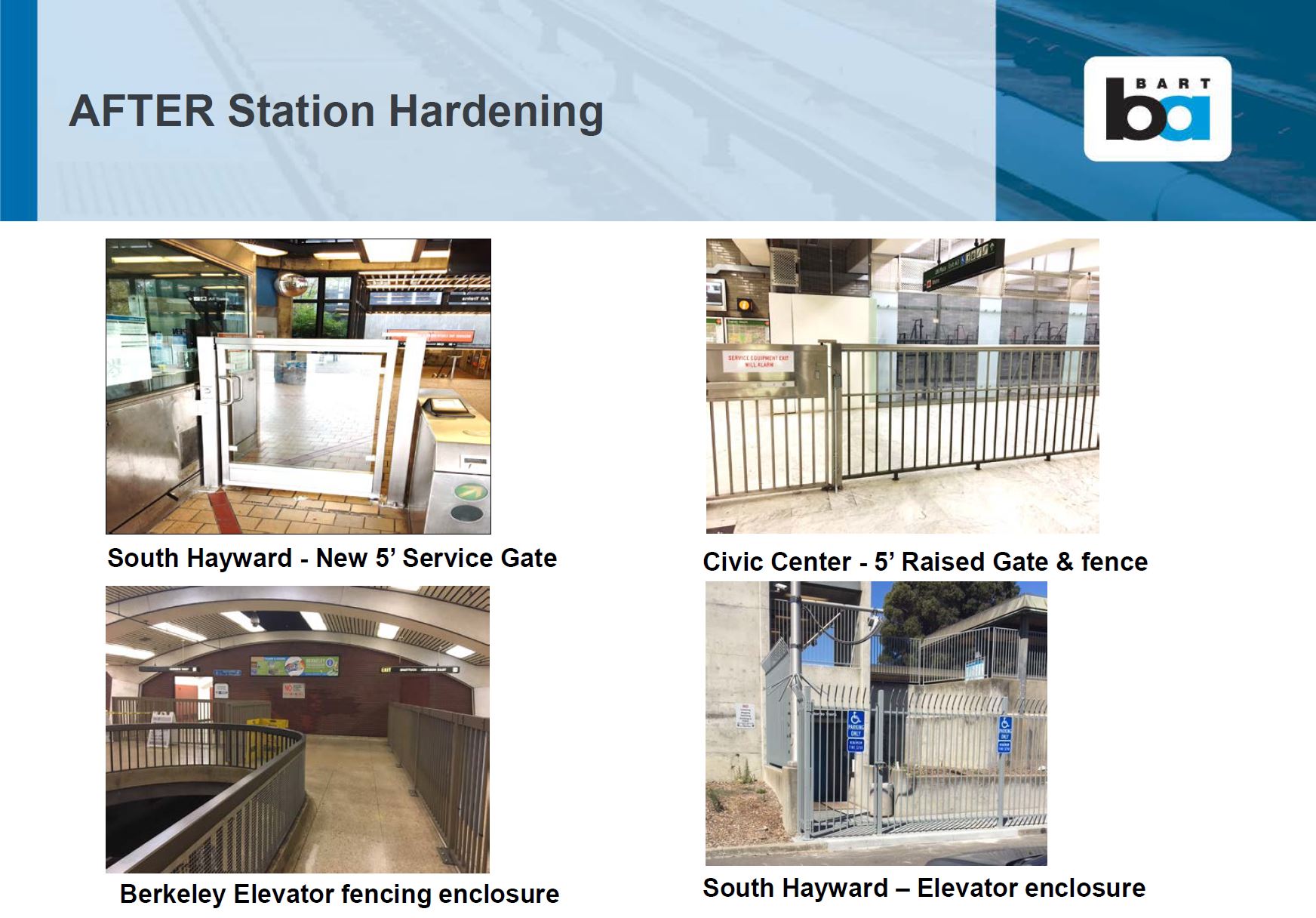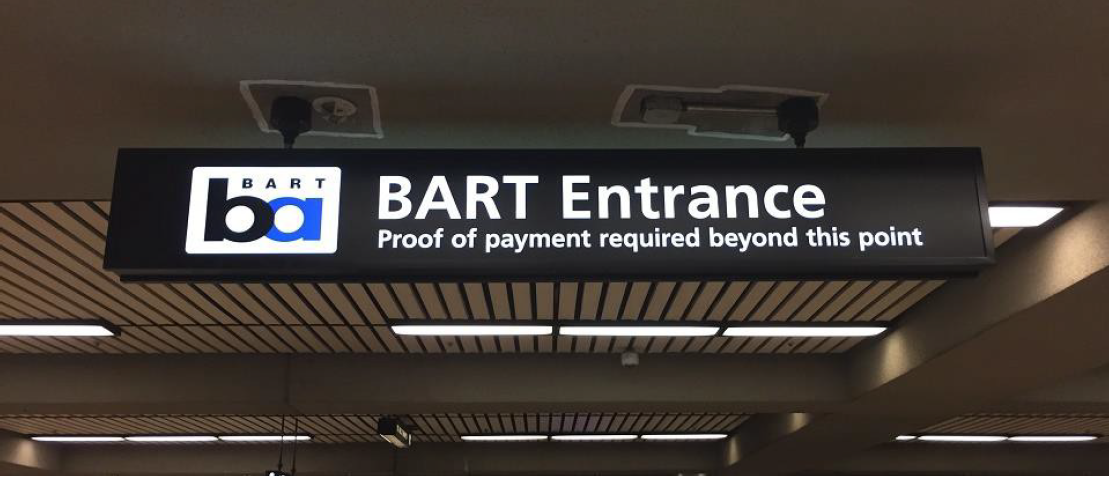BART has made the historic purchase of brand-new fare gates to be installed systemwide as part of its latest effort to improve the customer experience and overhaul safety in the system. The new fare gates bring a new look and improved experience, offering state-of-the-art technology that will boost safety by reducing fare evasion, enhancing access for people in wheelchairs and those who bring bikes and strollers on BART, and optimizing the reliability and maintenance needs of the fare gates.
View and download the Next Generation Fare Gate Project Fact Sheet.
View and download the latest schedule (updated April 2025).
Installing new fare gates to prevent fare evasion is an accountability requirement for BART to receive SB 125 emergency state funding in response to the pandemic.
Riders can provide feedback about the fare gates by using our comment form.
Project timeline:
The West Oakland pilot gates opened in December 2023.
Full deployment systemwide will be completed by the end of 2025.
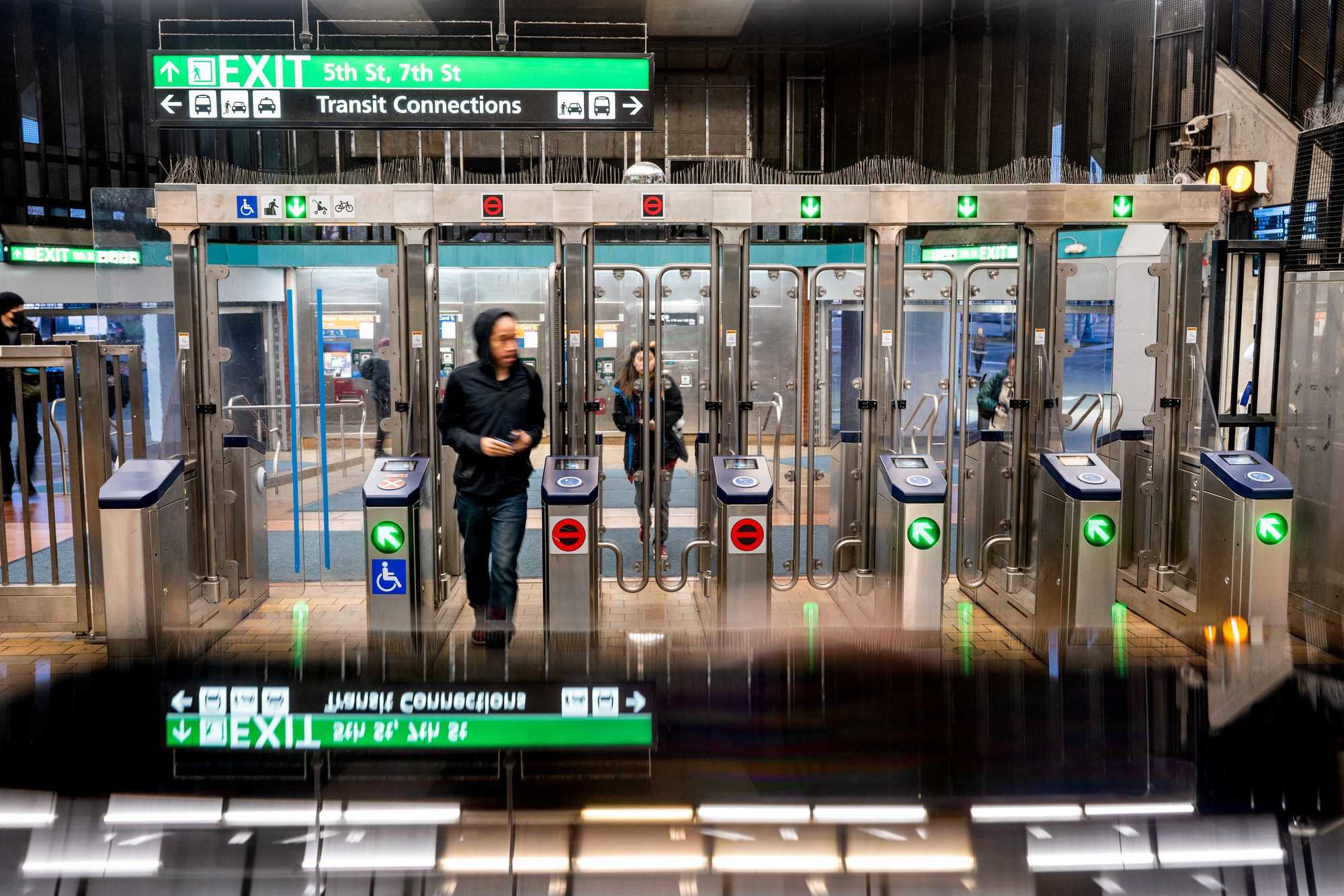
How the work is going:
29 Completed Stations | Completion Date |
| West Oakland (Prototype) | December 28, 2023 |
| Fruitvale | August 21, 2024 |
| Civic Center (Platform Gate completed April 2024) | August 29, 2024 |
| Richmond | September 13, 2024 |
| 24th Street/Mission | September 21, 2024 |
| OAC (Oakland Airport Connector) | September 20, 2024 |
| Antioch | September 30, 2024 |
| 16th Street/Mission | October 12, 2024 |
| SFO (San Francisco International Airport) | October 26, 2024 |
| Coliseum | November 1, 2024 |
| Powell Street | November 23, 2024 |
| Warm Springs | December 10, 2024 |
| Montgomery Street | December 18, 2024 |
| Dublin/Pleasanton | December 21, 2024 |
| Hayward | December 21, 2024 |
| South Hayward | January 10, 2025 |
| 12th Street | February 4, 2025 |
| Embarcadero | February 12, 2025 |
| Orinda | February 22, 2025 |
| Downtown Berkeley | February 25, 2025 |
| Lafayette | March 7, 2025 |
| Pittsburg Center | March 9, 2025 |
| Rockridge | March 10, 2025 |
| San Leandro | March 21, 2025 |
| Glen Park | March 21, 2025 |
| El Cerrito Plaza | April 9, 2025 |
| Concord | April 9, 2025 |
| El Cerrito del Norte | April 24, 2025 |
| MacArthur | April 24, 2025 |
Which stations are coming up:
Next Stations | Work Begins |
| Lake Merritt | April 2025 (Work underway) |
| Pittsburg/Bay Point | May 2025 |
| North Berkeley | May 2025 |
| North Concord/Martinez | May 2025 |
| Walnut Creek | May 2025 |
| Daly City | May 2025 |
| Pleasant Hill/Contra Costa Centre | May 2025 |
| Ashby | June 2025 |
| Millbrae | June 2025 |
| 19th St | June 2025 |
| West Dublin / Pleasanton | June 2025 |
| Bay Fair | June 2025 |
| Castro Valley | June 2025 |
| Union City | July 2025 |
| Fremont | July 2025 |
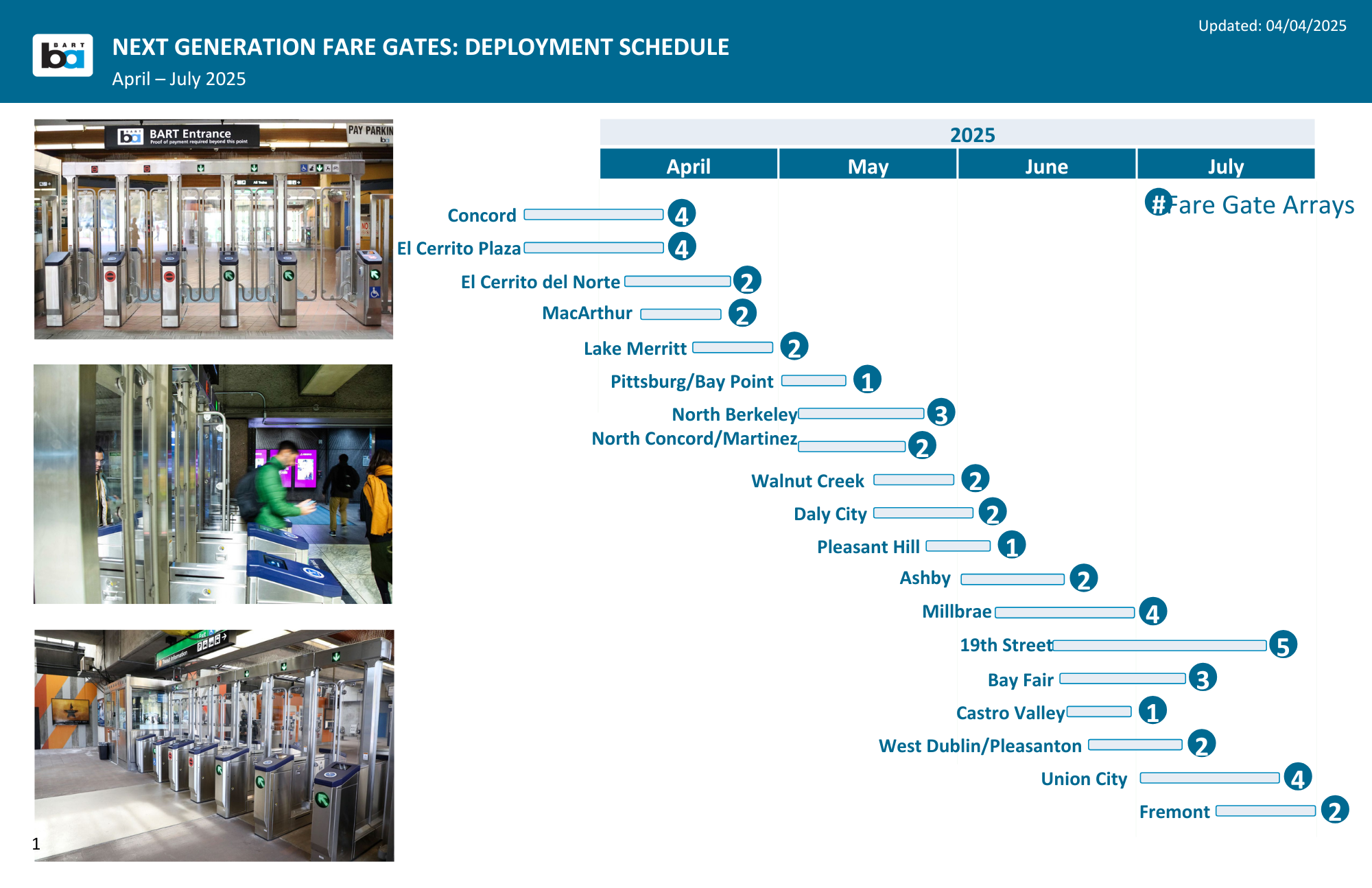
Get more information about discounts here:
The new fare gates don't show Clipper Card balances
The new fare gates make way for the next generation of Clipper, and all of the benefits that come with the upgrade of Clipper, including open payment (tapping a contactless credit or debit card at the fare gate to pay for a ride), free/discounted transfers, and a new grace period to avoid being charged if you change your mind once you enter the gate. These changes mean balances must be calculated by the Clipper back-office system in the cloud instead of the actual Clipper readers, which is why the updated balance can't be shown. The new Clipper card readers on the fare gates themselves no longer have fare calculation responsibilities. The experience will be similar to when you use a debit card to tap a retail device – those retail devices do not show your balance either. For the free or discounted transfers once they launch, your new balance won’t be calculated until the back office recognizes you rode more than one transit system and it can take multiple days for repricing.
To check your balance, you can tap your Clipper card at any BART vending machines, or digital cards in your phone’s wallet will show your balance. When the next generation of Clipper launches in spring 2025, the Clipper app will show your balance in real time.
Recognizing BART riders like seeing their balance, BART's General Manager has specifically asked Cubic (the Clipper vendor) to explore solutions to see if anything can be done to enable an accurate balance to be shown once again. Clipper is managed by the Metropolitan Transportation Commission, not BART.
Learn more about the background of the Next Generation Fare Gates project:
On December 28, 2023, BART opened the new fare gates at West Oakland station.
At the West Oakland Station BART tested three different door materials (Polycarbonate only, Polycarbonate framed with metal, and Polycarbonate with a perforated metal insert) and selected to advance the polycarbonate framed with metal.
Some datasets related to the West Oakland prototype:
- Through June 2024, the Next Generation Fare Gates at West Oakland have processed a combined total of 1.09 million entries and exits.
- Through June 2024, West Oakland saw nearly 120,000 more entries and exits compared with the same period in 2023.
- The 11% increase in entries and exits at West Oakland is nearly double the systemwide increase of 6%.
- While many riders are using Clipper on their phone, card sales remain strong at West Oakland. Card sales at West Oakland have been up every month of this year compared with 2023. Meanwhile, Clipper card sales have been down every month systemwide since March. (Jan-Feb Clipper sales at West Oakland were up 13%)
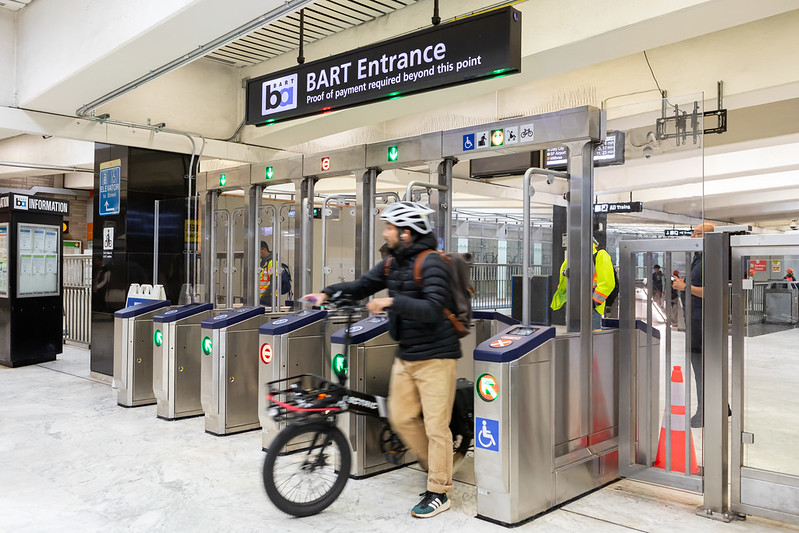
At the April 13, 2023 BART Board of Directors meeting, the Board moved forward with the first purchase of the $90 million Next Generation Fare Gate project. The board awarded up to $47 million to STraffic America to implement the project. The project calls for all stations to have new fare gates by the end of 2025.
The new fare gates will look unlike any other of the current 700 fare gates in the BART system. The gates will have clear swing barriers that will be very difficult to be pushed through, jumped over, or maneuvered under. The overall fare gate array height (gate, console, integrated barrier) will form a tall barrier of 72” minimum to prevent fare evasion.
The next generation fare gates will not have the orange fins riders have become accustomed to. They will also be different than the new swing-style fare gates designed by BART staff and recently installed to enclose elevators into the paid area.
The new gates will be able to handle large crowds without slowing people down as they move in and out of stations while processing their Clipper cards. The gates will have advanced 3D sensors that are able to detect if someone is in a wheelchair or has a bike, stroller, or luggage with them, allowing for more time before the swing barrier closes. The gates will have LED lighting on the swing barriers and the pathway through the gate to help visually impaired riders. STraffic has worked extensively with members of the ADA community and is committed to continue this work while designing the BART gates.
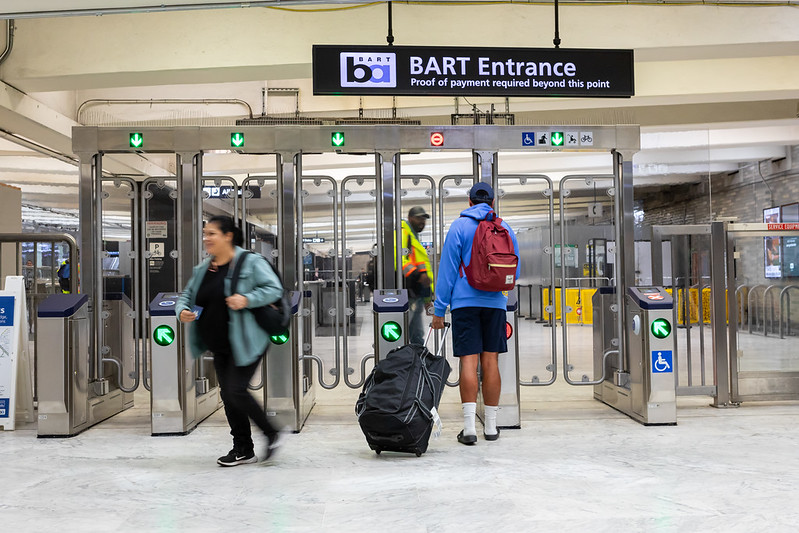
New fare gates systemwide will:
- Modernize our stations and provide a more welcoming appearance compared to our current fare gates
- Improve access for those who bring bikes, strollers, and luggage (while BART has wide accessible gates at every station, new technology will improve the experience)
- Deter fare evasion with a design people can't push through, jump over, or maneuver under
- Improve reliability of the gates (spare parts of the old gates are hard to find)
- Increase through-put to prevent lines
- Take advantage of state-of-the art features
Project benefits:
- Improve feelings of safety and boost ridership: the new fare gates will have tall swing barriers that will make it difficult for fare evaders to push through, hurdle over, or maneuver under. More secure fare gates should improve perceptions of safety and encourage riders to return.
- Improve customer experience: gates will have advanced sensors to detect wheelchair users and those with luggage, strollers, or bikes to ensure they get through with ease, and LED lighting to assist visually impaired riders.
- Increase reliability and reduce system downtime: the gates will be easier to maintain.
Enhance monitoring: the gates will contain sensors that can detect fare evasion to improve future deterrence efforts and provide real-time monitoring capabilities. - Modern Aesthetics: the new fare gates will help shift the look and feel of BART stations to the 21st century. Fewer BPD and Rider Confrontations: Secure fare gates will help self-enforce fare payment, removing potentially negative confrontation between would-be fare evaders and police.
- New Payment Options: The new gates will be compatible with the next generation of Clipper (when it becomes available) which will accept open payment with the ability to pay for BART by tapping a credit or debit card or a phone/watch with Apple Apple Pay or Google Pay at the gate.
Funding Sources:
To date, BART has secured $73 million of the $90 million project, with funding from:
- BART Funds (Operating-to-Capital Allocations and Measure RR) $23M
- County Transportation Agency Funds $28M
- Federal Funds $15M
- State Funds $6.5M
BART will continue to work to secure full funding from local, state, and federal sources.
Funding Partners:
- United States Department of Transportation (USDOT)
- Federal Transit Administration (FTA)
- State of California
- California Transportation Commission (CTC)
- California Department of Housing & Community Development (HCD)
- Metropolitan Transportation Commission (MTC)
- Alameda County Transportation Commission (ACTC)
- Contra Costa Transportation Authority (CCTA)
- San Francisco County Transportation Authority (SFCTA) Prop L Transportation Sales Tax
- Santa Clara Valley Transportation Authority (VTA)
- South Hayward JPA
- BART Measure R

BART General Manager Bob Powers released a statement on new fare gates:
“As a transportation system, we take tremendous pride in saying our riders are what runs BART. Among the world’s transit agencies, BART relies the most on rider fares; they are directly responsible for funding our operations. These new, state-of-the-art fare gates will protect against fare evasion, expand access to transit-dependent riders, and reduce system downtime due to maintenance, which helps boost investment in BART’s long-term growth.”
BART Police Chief Kevin Franklin also applauded the unveiling in a statement:
“We welcome the new fare gates starting at West Oakland and its future expansion to other stations. These stronger, higher gates will limit fare evasions through self-enforced fare payments, keep riders safe and engaged to return to BART, and have police officers focused on more serious situations that require emergency services.”
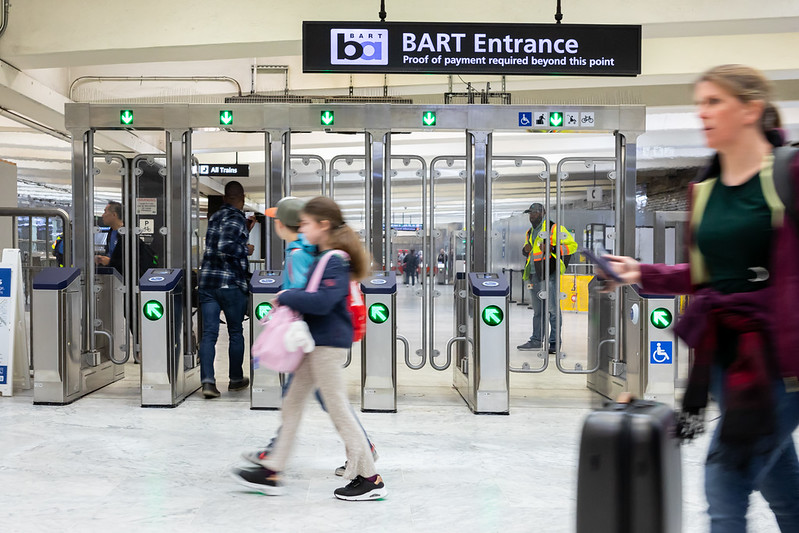
Timeline of Procurement
- The District posted a Competitive Negotiation (Best Value) Request for Proposal for our Next Generation Fare Gates on May 31, 2022 and then again on December 2, 2022.
- Proposals were reviewed beginning in January of 2023 and responsive vendors were interviewed by a BART panel.
- On March 23, 2023, staff recommended STraffic America to implement the project.
- On April 13, 2023 the Board awarded the contract to STraffic.
BART Prototypes Tested
BART has been piloting a swing style barrier fare gate design in multiple locations across the district. The 5-feet high barriers are operated with air pressure instead of a motor. There are fewer moving parts and the gates can apply as much pressure as necessary to discourage someone from pushing the barriers open. The prototype can process a minimum of 30 riders per minute which is a required benchmark to ensure riders can quickly move through our stations.
BART has installed prototypes at multiple stations including near elevators to bring the elevator into the paid area. This new change requires riders to pass through a fare gate if they use the elevator.
For riders who rely on elevators, the new elevator fare gates improve access to the station by streamlining the path to tag in or out of the station. Previously, tagging out of the station was difficult and cumbersome for those who are unable to reach around the fare gate to tag out after using the elevator.
The elevator fare gates at downtown San Francisco stations also speeds up the transfer to Muni. BART riders arriving by train in downtown San Francisco can now tag out at the platform and take the elevator to the Muni platform and then tag Clipper on board the Muni street car. Previously, BART riders had to travel up two levels to the concourse, reach around to tag out of BART at the fare gate, travel to the Muni entrance, tag in at their fare gate, and travel down one level.
Rockridge Station has an array of 3 connected single-barrier prototype fare gates (completed in August 2021).
All elevators that previously provided access to the paid area without a fare gate now have prototype fare gates to enclose elevators:
- Coliseum concourse (completed Aug 2020)
- Concord concourse (completed Oct 2020)
- Montgomery platform (completed Dec 2020)
- Bay Fair platform (completed July 2020)
- Balboa Park platform (completed August 2021)
- Embarcadero platform (completed December 2021)
- El Cerrito Plaza platform (two elevator fare gates) (completed May 2022)
- Rockridge platform (completed July 2022)
- Walnut Creek concourse (completed September 2022)
- North Berkeley platform (completed October 2022)
- Civic Center platform (completed January 2023)
- Powell platform (completed April 2023)
- Orinda concourse (completed July 2023)
Board presentations outlining the very latest on fare gate prototypes and replacement program:
December 5, 2024 Project update
August 15, 2024 Project update.
July 11, 2024 Project update.
January 11, 2024 Project update.
September 14, 2023 Project update.
April 13, 2023 Vendor selected, this presentation includes early concept renderings
March 23, 2023 Vendor recommendation
July 19, 2023 letter to Bay Area Council with update on new fare gate implementation.
Here is a picture of the accessible fare gate prototype installed at Richmond Station:
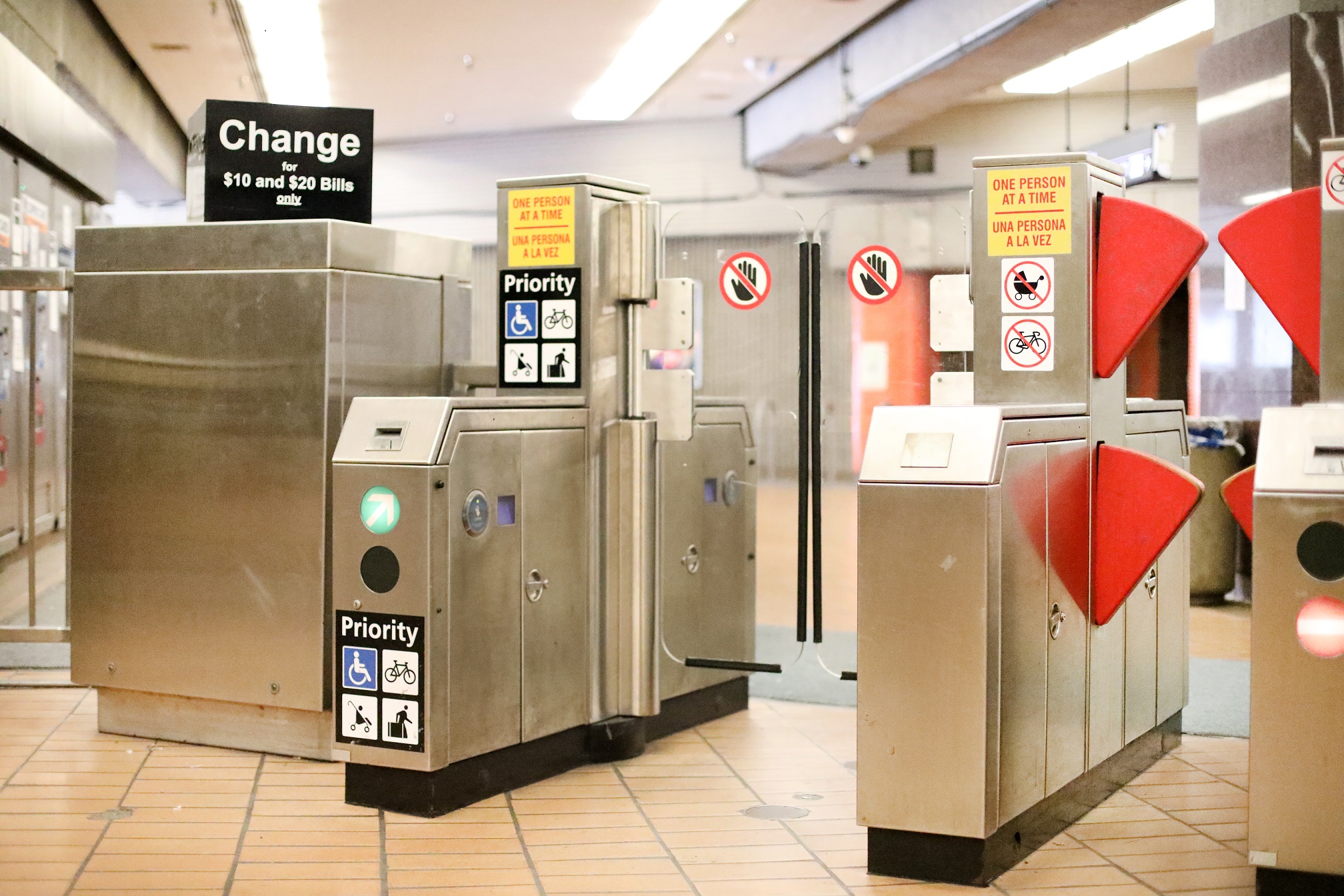
Here is a picture of the accessible fare gate prototype installed at the Concord station to bring the elevator into the paid area:
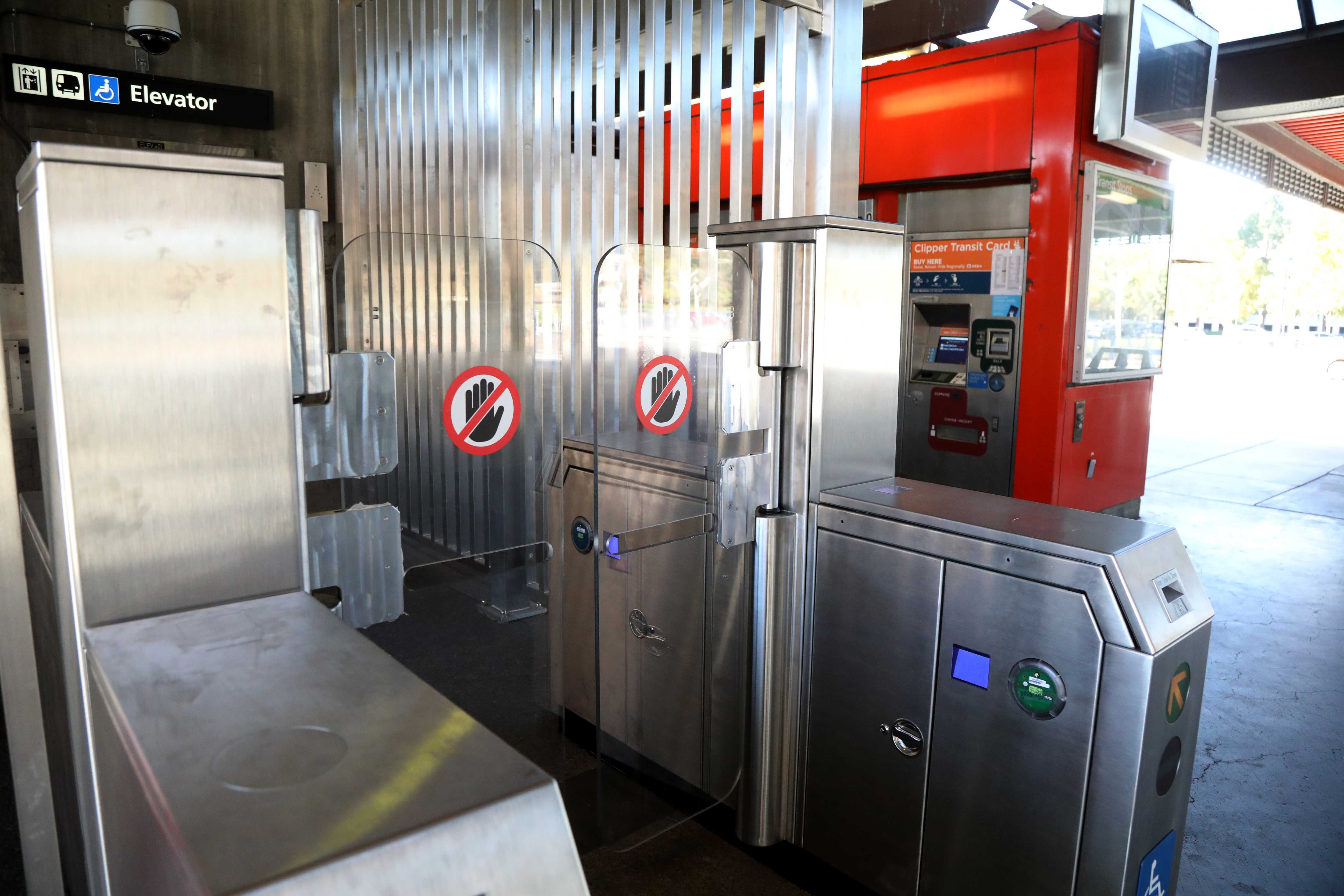
Here is the Embarcadero elevator fare gate located at the platform level:
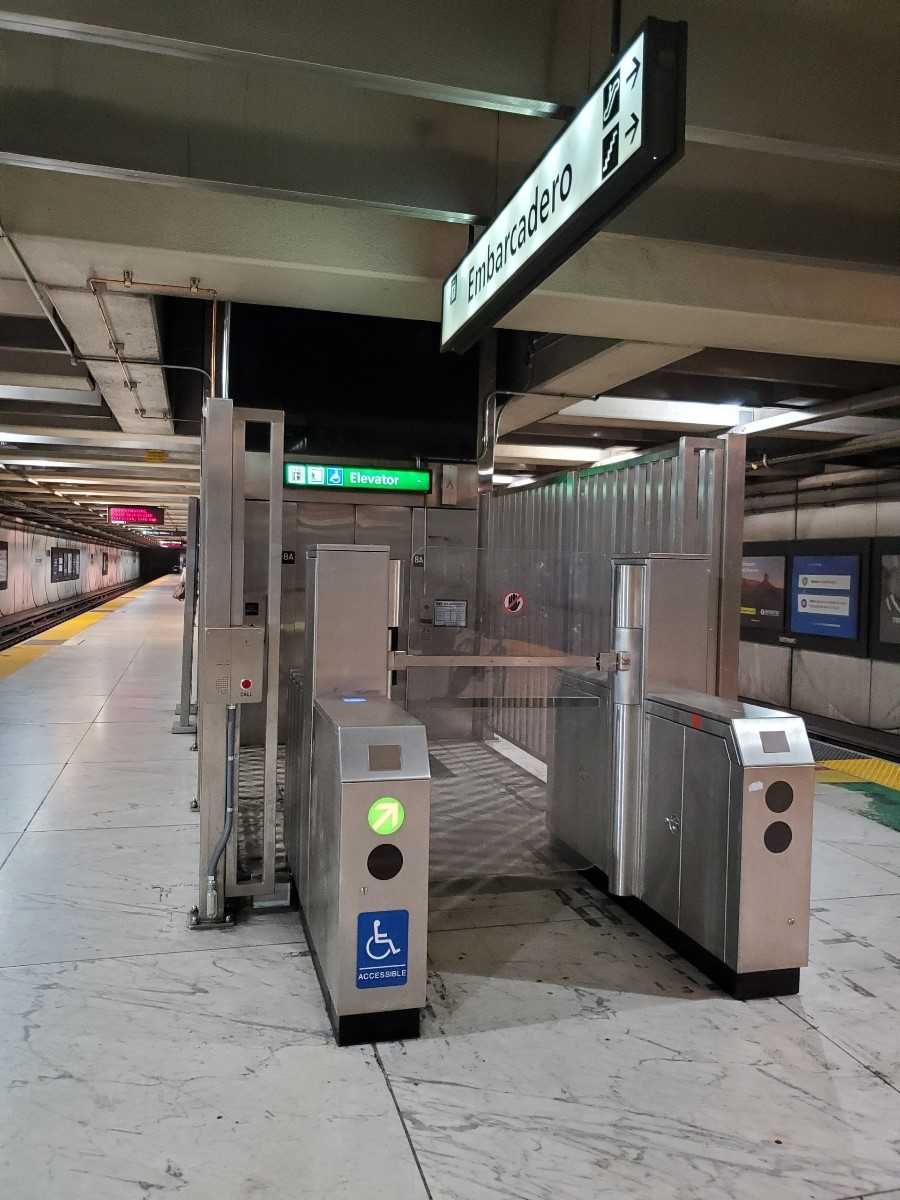
Modifications to current fare gate
In 2018 BART began making modifications to current fare gates. The modifications, designed to deter the ability to push through or jump over fare gates, and would provide an interim solution while funds are secured for a wholesale replacement program. The modified gate designs were reviewed by a safety engineering consultant.
When making these changes we design for safety including ensuring that we are not creating unsafe conditions for persons with mobility limitations. We conduct appropriate analysis and testing prior to implementation in public spaces. We also conduct operating environment tests, sometimes referred to as pilot tests. Field locations are selected based on station configuration, ridership patterns and feedback from frontline employees and BART Police.
Air Pressure Modifications
In 2018, BART retrofitted existing fare gates with a modification that applies pressure to fully closed gates, making it very difficult for anyone to push through the gates. This concept was piloted at Embarcadero first. The modification is designed such that the fare gate leaves close at normal pressure to ensure that there is no new risk to customers. Once fully closed the additional pressure is applied to prevent would-be fare evaders from forcing the gate open.
Richmond Station Pilot Project
A pilot that modified the fare gates at Richmond Station with upper flaps to create duplex leaf, stacked fare gates started on Sunday, June 9, 2019. Once the barriers are in the fully closed position, increased pressure is applied to prevent fare evaders from forcing them open
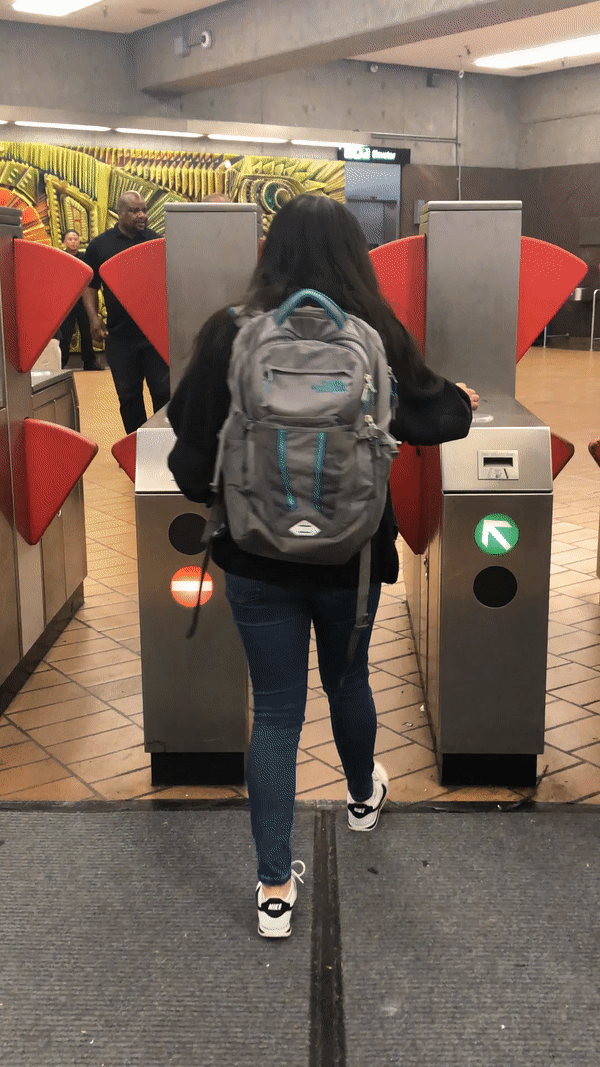

July 25, 2019 update:
Based on a limited count post installation there has been an overall fare evasion reduction of approximately 55 to 60%.
Feedback from frontline employees is that these gates have greatly contributed to a reduction in fare evasion and a greater sense of security.
The cost for this pilot has been $114,000.
Station Hardening
Station hardening is changing infrastructure other than the fare gates to prevent fare evasion. Changes include heightened barriers around paid areas, alarmed swing gates and exit doors, and elevators moved into paid areas. All these elements make it more difficult for fare evaders to bypass fare gates.
Station hardening is a substantial systemwide effort, leveraging new and existing operating and capital funds from a variety of sources into a wide range of projects
As of March 2022, all stations have been completed except the following stations scheduled for hardening in Fiscal Year '22
- North Concord
- Lafayette
- Orinda
- West Dublin/Pleasanton
- 19th Street
- Union City
Proof of Payment
Proof of payment began on January 1, 2018 with a two-month warning period for first time violators. The grace period ended in early March 2018 when fare inspectors began issuing tickets. Fare inspectors increase police presence on trains and in stations. They deter fare evasion, encourage compliance over time and promote customer equity sending the message that everyone must pay their fair share.
Fare inspections progress within paid areas from one person to the next without inspectors skipping anyone, whether in a station or on a train. They have no discretion regarding citations. All interactions are recorded with body worn cameras. Citations are civil with a fine of $55 for juveniles and $75 for adults. Community service is also an option.
BART’s Office of the Independent Police Auditor regularly reviews a random sampling of the fare inspectors' body worn camera footage.
